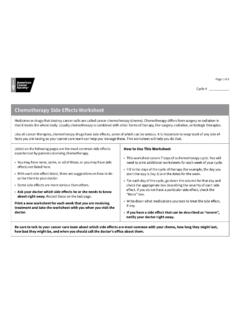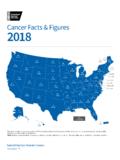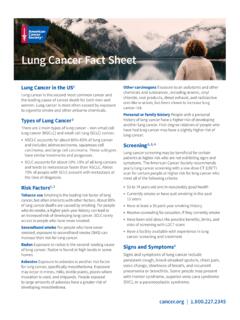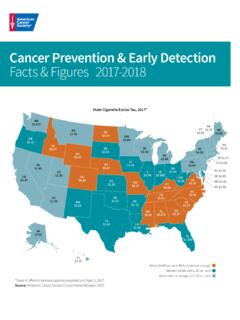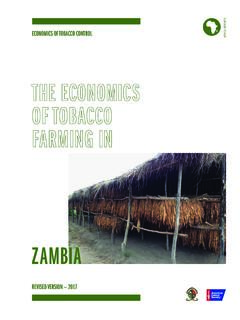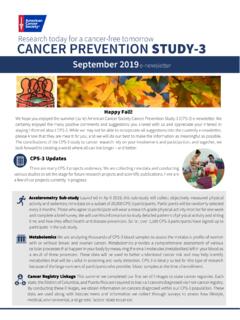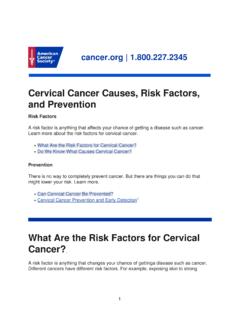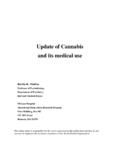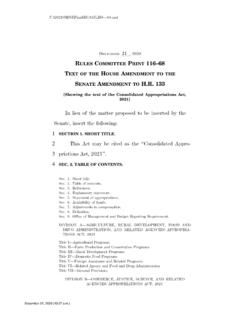Transcription of Lung Cancer Causes, Risk Factors, and Prevention
1 Lung Cancer Causes, Risk Factors, andPrevention | FactorsA risk factor is anything that affects your chance of getting a disease such as more about the risk factors for lung Cancer Risk FactorslWhat Causes Lung Cancer ?lPreventionThere is no way to completely prevent Cancer . But there are things you can do thatmight lower your risk. Learn Lung Cancer Be Prevented?lLung Cancer Risk Factors A risk factor is anything that increases a person s chance of getting a disease such ascancer. Different cancers have different risk factors. Some risk factors, like smoking,can be changed. Others, like a person s age or family history, can t be having a risk factor, or even several, does not mean that you will get the Cancer | some people who get the disease may have few or no known risk risk factors can make you more likely to develop lung Cancer .
2 These factorsare related to the risk of lung Cancer in general. It s possible that some of these mightnot apply to small cell lung Cancer (SCLC).Risk factors you can changeTobacco smokeSmoking1 is by far the leading risk factor for lung Cancer . About 80% of lung cancerdeaths are thought to result from smoking and this number is probably even higher forsmall cell lung Cancer (SCLC). It s very rare for someone who has never smoked tohave SCLC. The risk of lung Cancer for people who smoke is many times higher than for people whodon't smoke. The longer you smoke and the more packs a day you smoke, the greateryour smoking2 and pipe smoking are almost as likely to cause lung Cancer as cigarettesmoking.
3 Smoking low-tar or light cigarettes increases lung Cancer risk as much asregular cigarettes . Smoking menthol cigarettes might increase the risk even more sincethe menthol may allow people to inhale more smokeIf you don t smoke, breathing in the smoke of others (called secondhand smoke3 orenvironmental tobacco smoke) can increase your risk of developing lung smoke is thought to cause more than 7,000 deaths from lung Cancer you or someone you care about needs help quitting, see How To Quit Smoking orSmokeless Tobacco4 or call the American Cancer Society at 1-800-227-2345 Exposure to radonRadon is a naturally occurring radioactive gas that results from the breakdown ofuranium in soil and rocks.
4 You can t see, taste, or smell it. According to the USEnvironmental Protection Agency (EPA), radon is the second leading cause of lungcancer in this country, and is the leading cause among people who don't Cancer | , there is so little radon that it is not likely to be dangerous. But indoors, radoncan be more concentrated. Breathing it in exposes your lungs to small amounts ofradiation. This may increase a person s risk of lung and other buildings in nearly any part of the United States can have high indoorradon levels (especially in basements).For more information, see Radon and to asbestosPeople who work with asbestos (such as in mines, mills, textile plants, places whereinsulation is used, and shipyards) are several times more likely to die of lung Cancer risk is much greater in workers exposed to asbestos who also smoke.
5 It snot clear how much low-level or short-term exposure to asbestos might raise lungcancer exposed to large amounts of asbestos also have a greater risk of developingmesothelioma, a type of Cancer that starts in the pleura (the lining surrounding thelungs). For more on this type of Cancer , see Malignant recent years, government regulations have greatly reduced the use of asbestos incommercial and industrial products. It s still present in many homes and other olderbuildings, but it s not usually considered harmful as long as it s not released into the airby deterioration, demolition, or renovation. For more information, see Asbestos andCancer to other Cancer -causing agents in the workplaceOther carcinogens ( Cancer -causing agents) found in some workplaces that can increaselung Cancer risk include:Radioactive ores such as uraniumlInhaled chemicals such as arsenic8, beryllium, cadmium, silica, vinyl chloride, nickelcompounds, chromium compounds, coal products, mustard gas, and chloromethyletherslDiesel exhaust9lThe government and industry have taken steps in recent years to help protect workersfrom many of these exposures.
6 But the dangers are still there, so if you work around3 American Cancer | agents, be careful to limit your exposure whenever certain dietary supplementsStudies looking at the possible role of vitamin supplements in reducing lung Cancer riskhave had disappointing results. In fact, 2 large studies found that people who smokedwho took beta carotene supplements actually had an increased risk of lung Cancer . Theresults of these studies suggest that people who smoke should avoid taking betacarotene in drinking waterStudies of people in parts of Southeast Asia and South America with high levels ofarsenic10 in their drinking water have found a higher risk of lung Cancer .
7 In most of thesestudies, the levels of arsenic in the water were many times higher than those typicallyseen in the United States, even areas where arsenic levels are above normal. For mostAmericans who are on public water systems, drinking water is not a major source factors you cannot changePrevious radiation therapy to the lungsPeople who have had radiation therapy to the chest for other cancers11 are at higherrisk for lung Cancer , particularly if they smoke. Examples include people who have beentreated for Hodgkin disease12 or women who get chest radiation after a mastectomy forbreast cancer13. Women who have radiation therapy to the breast after a lumpectomydo not appear to have a higher than expected risk of lung pollutionIn cities, air pollution (especially near heavily trafficked roads) appears to raise the riskof lung Cancer slightly.
8 This risk is far less than the risk caused by smoking, but someresearchers estimate that worldwide about 5% of all deaths from lung Cancer may bedue to outdoor air or family history of lung cancerIf you have had lung Cancer , you have a higher risk of developing another lung Cancer | , sisters, and children of people who have had lung Cancer may have a slightlyhigher risk of lung Cancer themselves, especially if the relative was diagnosed at ayounger age. It s not clear how much of this risk might be due to shared genes amongfamily members and how much might be from shared household exposures (such astobacco smoke or radon).Researchers have found that genetics seems to play a role in some families with astrong history of lung Cancer .
9 (See What Causes Lung Cancer ?).Factors with uncertain or unproven effects on lung Cancer riskSmoking marijuanaThere are reasons to think smoking marijuana might increase lung Cancer smoke contains tar and many of same Cancer -causing substances thatare in tobacco smoke. (Tar is the sticky, solid material that remains after burning,which is thought to contain most of the harmful substances in smoke.)lMarijuana cigarettes (joints) are typically smoked all the way to the end, where tarcontent is the is inhaled very deeply and the smoke is held in the lungs for a long time,which gives any Cancer -causing substances more opportunity to deposit in marijuana is still illegal in many places, it may not be possible to controlwhat other substances it might who use marijuana tend to smoke fewer marijuana cigarettes in a day or weekthan the amount of tobacco used by people who smoke cigarettes .
10 The lesser amountsmoked would make it harder to see an impact on lung Cancer s been hard to study whether there is a link between marijuana and lung cancerbecause marijuana has been illegal in many places for so long, and it s not easy togather information about the use of illegal drugs. Also, in studies that have looked atpast marijuana use in people who had lung Cancer , most of the people who smokedmarijuana also smoked cigarettes . This can make it hard to know how much anyincreased risk is from tobacco and how much might be from marijuana. More researchis needed to know the Cancer risks from smoking Cancer | are a type of electronic nicotine delivery system.
